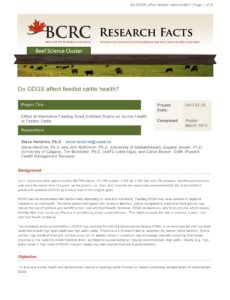Do DDGS Affect Feedlot Cattle Health?
Corn, wheat and other grains contain 68-70% starch, 10-13% protein, 2-4% oil, 2-3% fiber and 2% minerals. Bioethanol production only uses the starch from the grain. Therefore, the protein, oil, fiber, and minerals are much more concentrated in the dried distillers’ grains with solubles (DDGS) by-product than in the original grain.
DDGS may be incorporated into feedlot diets depending on cost and availability. Feeding DDGS may have positive or negative impacts on animal health. The increased sulfur concentration in DDGS may increase the risk of polioencephalomalacia (PEM), a nervous disorder that has been observed in both high grain diets and high sulfur diets.
A recently-completed research project funded by the National Check-off and Canada’s Beef Science Cluster evaluated animal health and performance impacts of yearling cattle finished on rations containing variable levels of wheat-based DDGS.
The study found that dietary sulfur levels can vary among different sources of DDGS, and this can affect sulfur levels in the rumen, blood and urine. Feeding DDGS at up to 40% of the diet did not increase the risk of PEM or metabolic disease in these studies.
To learn more about this research, view the fact sheet (web version).
Click here to subscribe to the BCRC Blog and receive email notifications when new content is posted.
The sharing or reprinting of BCRC Blog articles is welcome and encouraged. Please provide acknowledgement to the Beef Cattle Research Council and list the website address, www.BeefResearch.ca.
We welcome your questions, comments and suggestions. Contact us directly at [email protected] or generate public discussion by posting your thoughts below.
Stay connected by following us on Twitter @BeefResearch, liking us on Facebook, and subscribing to our YouTube Channel.
